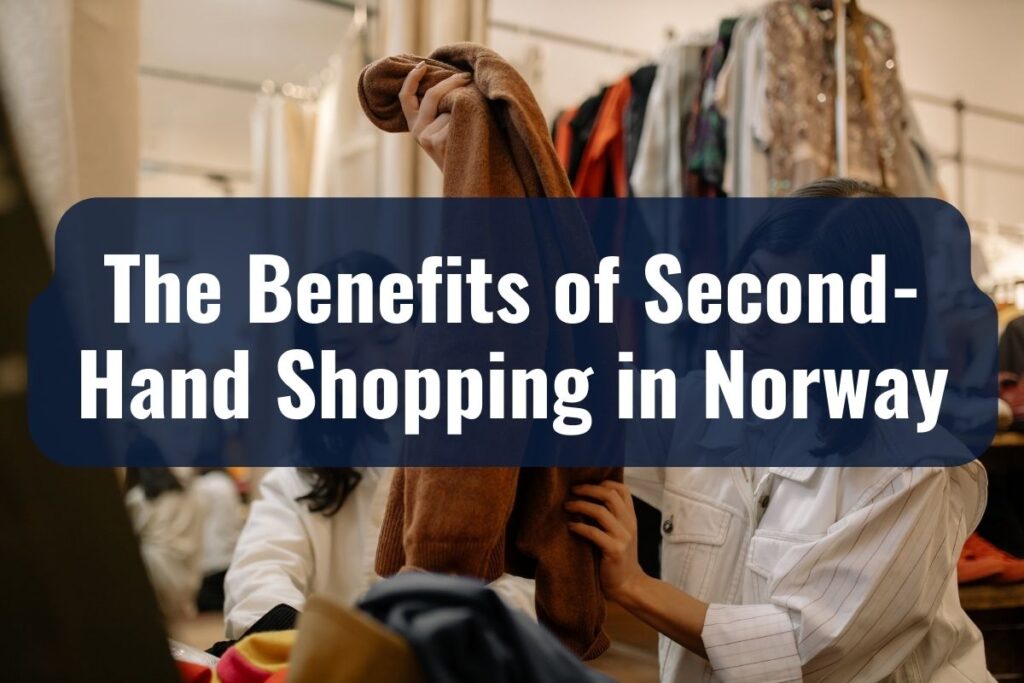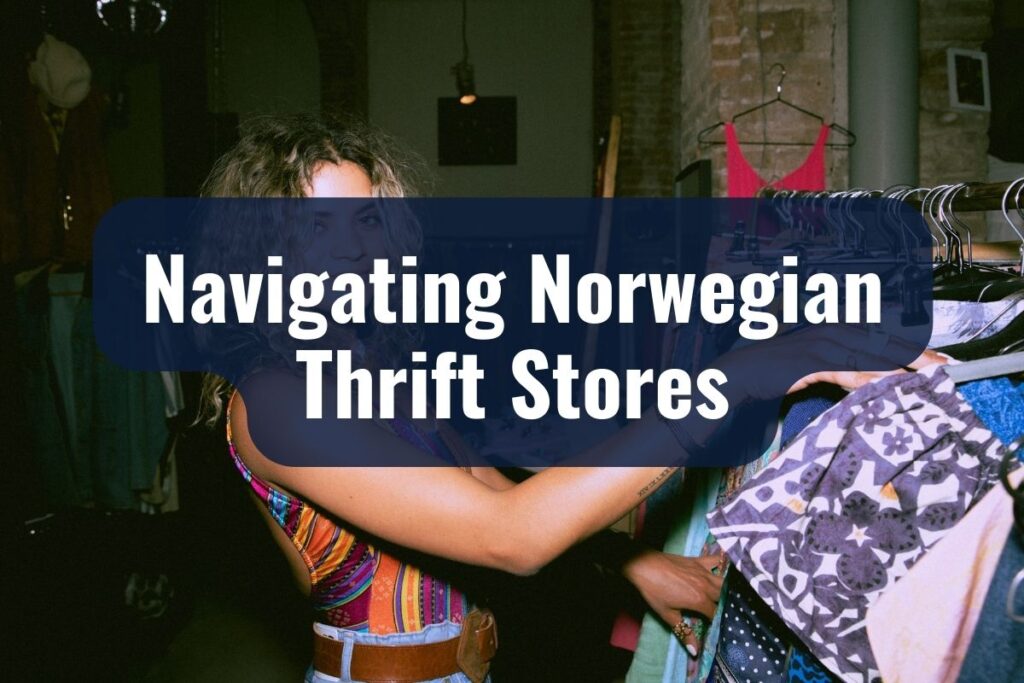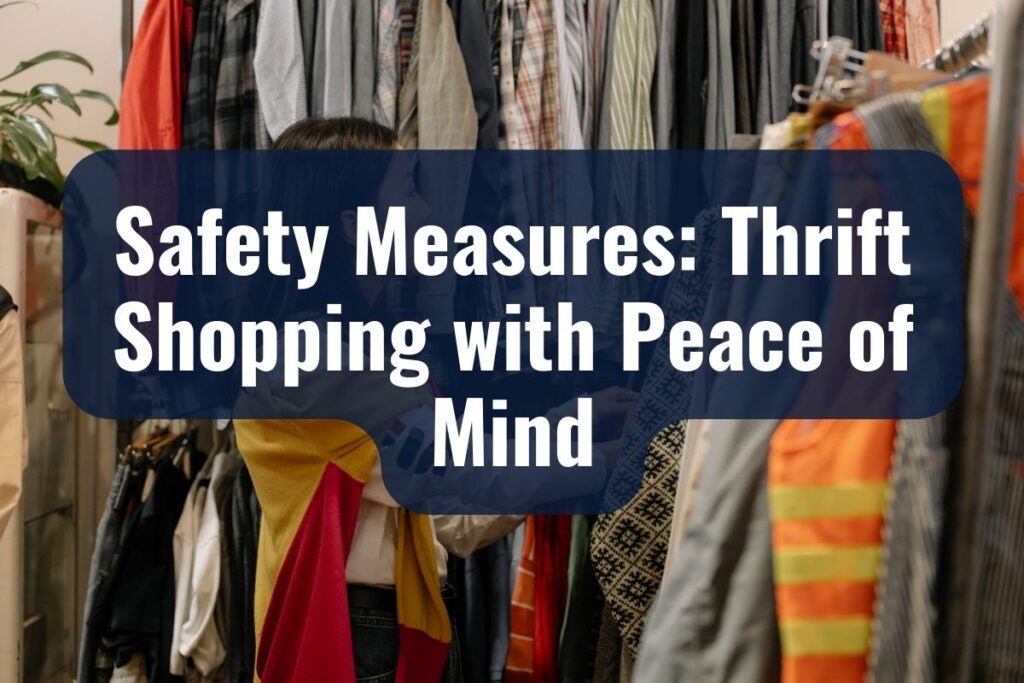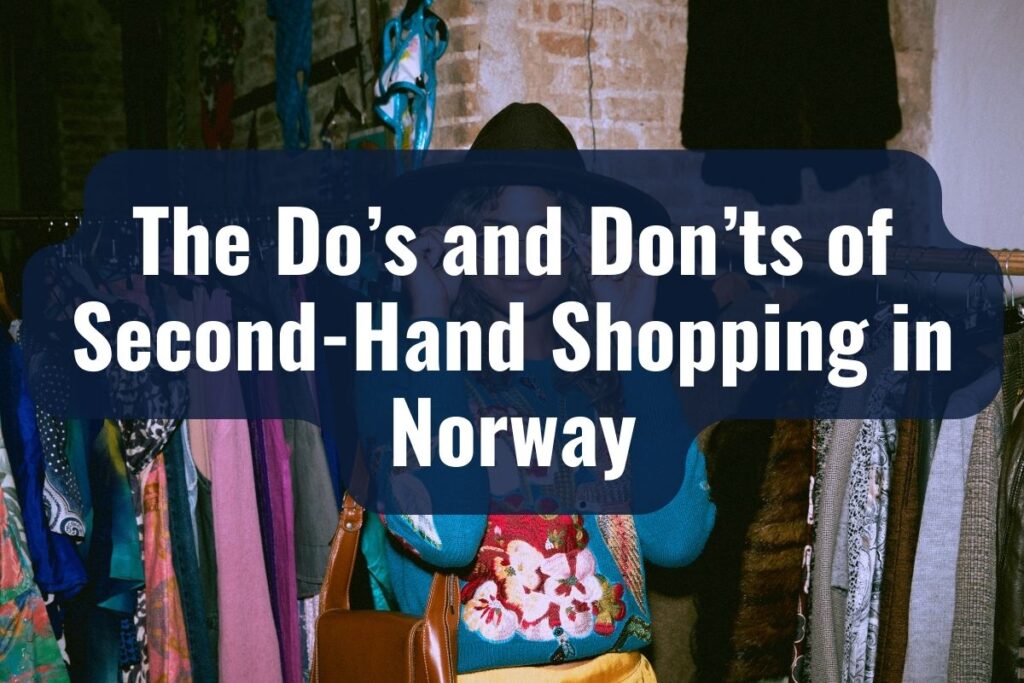Did you know that Norway is also a paradise for budget-conscious treasure hunters like you?
Step into second-hand stores in Norway, and you’ll find yourself amidst a potpourri of hidden gems. And the best part? You don’t have to be fluent in Norwegian to navigate this realm of endless possibilities.
Let this guide be your compass as you navigate through Norway’s second-hand stores, and who knows, you might just stumble upon the find of a lifetime!
Key Takeaways
- Thrifting in Norway offers a cost-effective, eco-friendly, and adventurous shopping experience.
- Types of second-hand stores range from general thrift stores to specialized vintage and antique shops.
- High-profile stores like Fretex and Bruktbutikken are great starting points for your thrifting journey, while lesser-known stores and online marketplaces offer a wider range of unique finds.
- Timing, bundling, and polite haggling can help you secure better deals.
- Safety measures, including choosing reputable stores and sanitizing purchases, ensure a secure shopping experience.
- Online platforms like Finn.no and Tise offer convenient alternatives to in-store shopping.
The Benefits of Second-Hand Shopping in Norway

Let’s face it, Norway isn’t the cheapest country to live in or visit. So, yes, saving money is a significant benefit of second-hand shopping. But let’s delve deeper into why thrifting in Norway is more than just a cost-saving measure—it’s an experience that extends rewards far beyond your wallet.
Joining the Green Revolution
Norway is often at the forefront of sustainability and environmental consciousness. Shopping second-hand aligns perfectly with this. Every item you purchase is one less item that ends up in a landfill.
Plus, you’re contributing to the circular economy, helping to reduce the demand for new products and the natural resources they consume. So, while you snag that affordable, stylish jacket, take a moment to pat yourself on the back—you’re being eco-friendly too!
Discover Unique Treasures
Step into a second-hand store in Norway, and you’re stepping into a world of variety and charm. Each item carries its own story and its own personality. Unlike mass-produced goods, second-hand items often have a history and character that make them uniquely yours.
From traditional Norwegian wool sweaters to vintage vinyl records featuring iconic Scandinavian musicians, second-hand stores are a haven for one-of-a-kind finds that you won’t discover elsewhere. Think of it as a form of treasure hunting, where you’re not just saving money but also acquiring pieces that have their own unique tale to tell.
A Cultural Expedition
Don’t underestimate the cultural richness that accompanies second-hand shopping. It’s an experience that can immerse you in the local Norwegian community.
While tourists flock to famous landmarks and city centers, you’ll be mingling with locals, maybe even striking up conversations that teach you a thing or two about Norwegian culture and lifestyle. Thrifting can be a gateway into understanding the intricacies of life in Norway, beyond the scope of typical tourist guides.
Popular Types of Second-Hand Stores in Norway
Thrift Stores: The Cornucopia of Finds
When you hear the phrase “second-hand store,” thrift stores are probably what come to mind. These stores are everywhere in Norway, and they are packed with a wide array of items—from clothing and books to furniture and electronics. It’s like stepping into Aladdin’s cave; you never know what treasures await you!
Plus, the majority of thrift stores in Norway are run by charitable organizations, meaning your money is going towards a good cause.
Vintage Stores: A Curated Experience
If you have an eye for fashion and a love for all things vintage, then Norway’s got you covered. Vintage stores offer a carefully curated selection of high-quality, often designer items. These are the spots to find a statement piece that adds oodles of personality to your wardrobe.
Imagine walking away with a retro Norwegian leather jacket that becomes the conversation starter at every gathering. Or perhaps a vintage evening dress that transports you to the glam of decades past. The attention to detail in these stores is impeccable, and it’s a real treat for fashion aficionados looking for something special.
Online Marketplaces: Thrift at Your Fingertips
No time to physically visit stores? No worries! Norway’s digital world offers some fantastic online platforms for second-hand shopping. These online marketplaces are just as diverse as brick-and-mortar stores, and they have the added advantage of being accessible from the comfort of your couch. Perfect for those winter days when you’d rather stay wrapped up in a cozy blanket but still crave the thrill of a good find.
| Type of Store | Characteristics | Examples of Items Sold |
| General Thrift | Wide range of items at low prices | Clothes, furniture, books |
| Vintage | Specializes in items from past eras | Vintage clothing, antiques |
| Antique | High-end, collectible items | Fine art, jewelry, rare books |
| Specialty | Focused on a specific category | Music records, sports gear |
| Online | Various items sold through websites | All of the above |

Language Barrier? No Problem!
One of the first concerns people often have about navigating thrift stores in a foreign country is the language barrier. Fortunately, in Norway, this is hardly an issue. Norwegians are known for their excellent command of English, making communication a breeze. Yet, knowing a few basic Norwegian phrases can not only make your shopping experience smoother but also endear you to the locals.
Key Norwegian Phrases to Know
- “Hvor mye koster dette?” — This translates to “How much does this cost?” and is essential for any shopping excursion.
- “Har du mer?” — This means “Do you have more?”, handy for when you find something you love and wonder if there are other similar items.
Convenient Payment Options
You might be asking yourself, “Will I need to carry a ton of cash?”
The good news is most thrift stores in Norway readily accept credit and debit cards. However, for those hidden gems like local markets or smaller stores off the beaten path, it’s advisable to keep some cash handy.
Tags, Labels, and Sizes
Unlike many other countries where the price tag might require decoding, Norway’s price tags are typically straightforward. They display the cost clearly, and often, you’ll also find size and material information.
However, remember that clothing sizes use European metrics, so they may be different from what you’re used to. It’s always a good idea to try on clothes to ensure they fit just the way you like.
What’s in Store: A Spectrum of Goods
Norwegian thrift stores can be a smorgasbord of items. You can find clothing, books, home décor, kitchenware, electronics, and even sporting goods! Take your time to explore each section—you might find that the ‘perfect’ item is tucked away in a corner you hadn’t considered checking.
Being a Smart Shopper
Inspect items carefully before making a purchase. Quality varies in thrift stores, and while many items are in excellent condition, it’s always wise to check for any wear and tear, especially for electronic goods and furniture.
Related: The Best Credit Cards in Norway for Foreigners
Top Picks: Well-Known Second-Hand Stores in Norway
Fretex: A Thrift-Store Chain with a Heart
When you think of thrifting in Norway, Fretex is likely the first name that comes to mind. Operated by the Salvation Army, Fretex is more than just a store; it’s a community-centric initiative that focuses on social work as much as it does on sustainable living.
With locations all over the country, you’re never too far from a Fretex outlet. Each visit offers a new selection of clothes, furniture, books, and even vintage collector’s items! Who knows, you might find that quintessential Norwegian knit sweater you’ve been dreaming of, all while supporting a fantastic cause.
UFF Second-Hand Stores: Quality Meets Affordability
The UFF stores in Norway are another treasure trove for second-hand items. With quality that goes hand in hand with affordability, UFF offers a wide array of products, from clothes and accessories to household items. Plus, UFF is big on community and environmental responsibility, so you can feel good about where your money is going.
Bruktbutikkene: The Local Experience
Translated as “The Second-Hand Stores,” Bruktbutikkene are usually smaller shops often found in smaller towns and even some city neighborhoods.
These stores offer a more localized experience and are fantastic for immersing yourself in the community. The items in these stores often reflect local styles and histories, making them a great spot for picking up something uniquely Norwegian.
Velouria Vintage: The Go-To for Retro Fashion
For those with a soft spot for retro and vintage fashion, Velouria Vintage in Oslo is a must-visit. It’s where fashion-forward Norwegians go to find pieces that make a statement.
From classic Norwegian brands to international vintage couture, the shop offers a feast for the eyes and the wardrobe.
Finn.no: Norway’s Craigslist
Don’t forget about the digital space! Finn.no is like the Craigslist of Norway and a marketplace for all sorts of second-hand treasures. It’s a great place to snag deals on furniture, electronics, and even cars. And since it’s online, you can shop anytime, anywhere!
Hidden Gems: Lesser-Known Spots for Thrifty Shopping

Gia’s: A Cozy Spot for Curated Finds
Nestled in the heart of Trondheim, Gia’s is a small but mighty treasure chest of curated items. This boutique thrift store leans into the aesthetic of ‘charmingly eclectic,’ making it an ideal place to find that offbeat piece of furniture or art that can transform a room. It feels more like you’re visiting a collector’s house than a store, and each piece is carefully selected to ensure it has both character and quality.
Nøstebarn: For the Little Ones
If you’re shopping for children’s clothing and accessories, Nøstebarn is a hidden gem that’s worth the detour. This store specializes in organic and second-hand items for children, making it perfect for parents who prioritize both quality and sustainability.
The soft, organic fabrics used in their clothing line are gentle on your child’s skin and on the environment. While not entirely a second-hand store, their collection often includes well-preserved preloved items at a fraction of the cost of new ones.
Hærverk: A Vinyl Lover’s Paradise
Located in Oslo, Hærverk is a haven for vinyl enthusiasts. This specialty store offers a curated selection of vintage and second-hand records that span various genres.
From classic Norwegian rock to international hits, the collection here is a music lover’s dream come true. It’s not just a store but a cultural hotspot, often hosting in-store events and DJ sets. Imagine stumbling upon a rare Norwegian vinyl that becomes the soundtrack to your life!
Emmaus Björkå: A Touch of Swedish Charm
Though originating in Sweden, Emmaus Björkå has become a beloved name in Bergen, Norway. This thrift store offers a kaleidoscope of items from clothes and books to home decor and small furniture. The atmosphere is inviting, and the layout encourages leisurely browsing. It’s the kind of place where you’ll lose track of time, delighting in each new discovery.
Robot: The Pop-Culture Emporium
Hidden away in Oslo, Robot specializes in pop-culture memorabilia, vintage clothing, and collectibles that will make any nerd’s heart skip a beat. From comic books to retro video games, the variety here is not only exceptional but also nostalgic. This is the place to go if you’re looking for something uniquely quirky that brings back fond memories of yesteryears.
Bargain Tips for Second-Hand Shopping
Go Off the Beaten Path. One of the best ways to find excellent deals is to explore second-hand stores in less touristy areas. These stores are often less picked-over and can offer lower prices than those in high-traffic areas. Plus, the hunt for these far-off places is an adventure in itself, adding to the overall thrifting experience.
Seasonal Thrifting: Timing is Everything. Each season brings its own set of goods into second-hand stores. Want a stylish winter coat or those signature Norwegian wool mittens? Try shopping during the spring or summer when demand for winter items is low, and prices are more negotiable. Likewise, summer items are often more affordable during the colder months.
Master the Art of Haggling. While not every store will be open to it, there’s no harm in trying to negotiate a better deal, especially if you’re buying multiple items. Be polite, and know the price range of what you’re looking for. A smile and a friendly approach can go a long way when you’re trying to snag that bargain.
Weekday Wonders. Weekends are the busiest times for thrift stores, which means the best items often get snapped up quickly. If your schedule allows, consider shopping on weekdays, preferably in the morning. Not only will you avoid the weekend crowds, but you’ll also get first dibs on newly stocked items.
Inspect Before You Buy. Always, always check the condition of an item before you purchase it. Look for any stains, tears, or missing parts that could affect its value. For electronics, ask if you can plug them in to ensure they work. Some stores have return or exchange policies, but it’s best to go in assuming that all sales are final.
Bundle Up for Savings. When you find several items you like at a single store, consider asking for a bundle price. Sellers are often willing to offer discounts on multiple-item purchases. This can be particularly effective at smaller, locally-run shops where the owners have more flexibility with pricing.
Stay Updated. Many second-hand stores and online platforms offer newsletters or have social media pages. Following these can give you a heads-up on sales, special offers, and new arrivals. It’s an easy way to stay in the loop and catch deals as they come up.
Safety Measures: Thrift Shopping with Peace of Mind

Know the Source: Reputable Stores are Key. One of the fundamental steps to ensure a safe shopping experience is choosing well-known or highly recommended stores. These stores usually have strict procedures for checking the quality and safety of the items they sell, so you can shop with confidence.
Cashless Transactions: A Touch of Modernity. In the era of contactless payments, many thrift stores in Norway offer the option to pay by card or even via mobile apps. This not only eliminates the need to carry a wad of cash but also adds a layer of safety to your shopping experience.
Keep an Eye on Your Belongings. Thrifting often involves rummaging through bins, racks, and shelves, which could easily distract you from your personal items. Always keep your belongings close to you and consider using a crossbody bag or a backpack with zipped compartments to deter pickpocketing.
Clean and Sanitize: The Name of the Game. Given the second-hand nature of the items, it’s a good idea to clean or sanitize your purchases once you get home. Most clothing items can be washed or dry cleaned, while furniture and electronics can be wiped down with disinfectant. For items like books or delicate fabrics, airing them out can be a good alternative.
Digital Caution: When Shopping Online. If you’re venturing into the digital thrift world, like on Finn.no, always be cautious. Choose sellers with good ratings, and if a deal seems too good to be true, it probably is. Secure payment methods and communication through the platform can add an extra layer of security to your transactions.
Examine Electrical Items Thoroughly. If you’re eyeing a preloved electronic gadget, it’s essential to test it before purchasing. Ask the store staff if you can plug it in to make sure it’s operational. Also, check for any signs of damage to the wiring or plugs, as faulty electronics can be a safety hazard.
Online Alternatives: Thrift Shopping from the Comfort of Home
Finn.no: The All-Encompassing Marketplace
As previously mentioned, Finn.no is the go-to online marketplace for everything second-hand in Norway. It’s similar to Craigslist but with a Norwegian twist.
Here, you can find anything from furniture and clothing to cars and electronics. The user-friendly interface and the rating system make it easy for you to gauge the credibility of sellers.
Tise: The Fashion-Forward Platform
If you’re particularly interested in fashion, Tise is the app for you.
This mobile platform focuses on second-hand clothing, accessories, and even beauty products. Users can follow each other, similar to a social network, and keep up to date on the latest wardrobe additions of fashion-conscious Norwegians.
Facebook Marketplace and Groups
Don’t underestimate the power of social media when it comes to online thrifting. Facebook Marketplace offers a variety of second-hand items, and you can even find location-specific or category-specific groups dedicated to buying and selling.
Whether it’s “Second-hand Furniture in Oslo” or “Vintage Clothing in Bergen,” there’s likely a Facebook group that caters to your needs.
Shpock: The Boot Sale App
Shpock is another mobile-centric platform, mimicking the concept of a car boot sale but in digital form. It’s highly visual, showing items in a grid format, and allows users to negotiate prices through its built-in chat function.
While not as popular as Finn.no or Tise, Shpock offers an alternative for those looking to break away from the more mainstream platforms.
Epla: For Handmade and Vintage
Epla is a Norwegian online marketplace focusing on handmade and vintage items. While it leans more towards new, artisanal creations, the vintage section is filled with second-hand treasures waiting to be discovered. If you’re looking for something uniquely Norwegian or even just one-of-a-kind, Epla is a must-visit site.
eBay and Etsy for International Options
For those open to shopping from international sellers, eBay and Etsy offer plenty of second-hand and vintage options. Keep in mind that international shipping fees and longer delivery times might apply, but you could find that special something not available anywhere else.
The Do’s and Don’ts of Second-Hand Shopping in Norway

Do: Embrace the Adventure
Thrifting is not just about the end goal of buying something; it’s about the journey of discovering unique, hidden gems. So set aside ample time to explore the racks, bins, and shelves. You might stumble upon a quirky vintage vase or a classic Norwegian book that you didn’t even know you needed!
Don’t: Overlook the Details
Inspect items for any signs of wear and tear, stains, or missing pieces. Especially with clothing, it’s easy to get excited about a fantastic find and overlook a minor flaw that becomes a major annoyance later on. Always scrutinize before you buy.
Do: Learn Basic Norwegian Phrases
While many Norwegians speak excellent English, it’s both polite and practical to learn a few basic Norwegian phrases for shopping. Simple terms like “Hvor mye koster det?” (How much does it cost?) can make your thrifting experience smoother and more engaging.
Don’t: Be Afraid to Walk Away
If something isn’t quite right or the price is too steep, don’t feel pressured to make a purchase. Thrifting is as much about knowing when to pass as it is about knowing when to buy.
Do: Ask About Payment Methods
Although most stores accept cards, it’s always a good idea to ask about payment options before you start shopping. Some smaller stores or market stalls might only take cash, so it’s best to be prepared.
Don’t: Ignore Cultural Etiquette
Norwegian culture values politeness and respect for personal space. Always queue in line patiently, and keep your voice at a moderate volume. Being courteous goes a long way, especially when you’re a guest in a new country.
Do: Check Return Policies
Especially for bigger or more expensive items, it’s wise to check if the store has a return or exchange policy. This gives you a safety net in case your purchase doesn’t work out as expected.
Don’t: Rush Through Stores
The best thrift finds often require some digging. Take your time to explore all sections of a store. Remember, one person’s trash is another person’s treasure, and you never know where that next marvelous find will appear.


